Tracking the Trends: A Comprehensive Look at the Popularity of Fitness Apps and Health Gadgets Over the Years
Fitness apps for your phone are mobile applications designed to help users track, manage, and improve their fitness and health routines. They offer various features, including workout plans, nutrition tracking, progress monitoring, and more. Here are some common types and examples of fitness apps:
- Workout Apps:
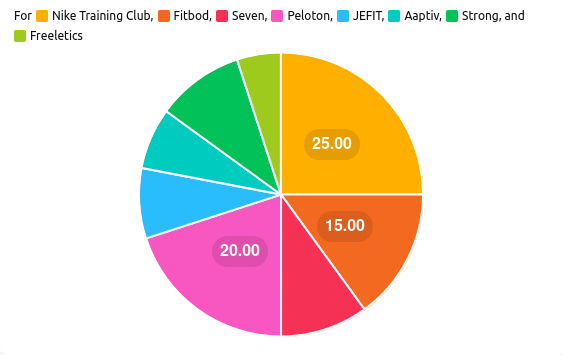
- Nike Training Club (25%): Offers a variety of workouts from strength and endurance to mobility and yoga, with guidance from Nike trainers.
- Fitbod (15%): Provides personalized workout plans based on your fitness level, goals, and available equipment.
- Seven (10%): Features seven-minute workouts for those with limited time, using bodyweight exercises that can be done anywhere.
- Running and Cycling Apps:
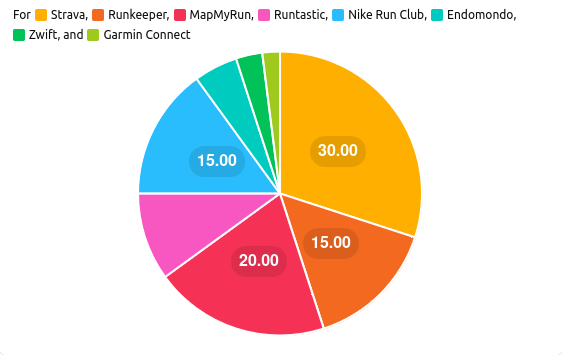
- Strava: Tracks running and cycling activities using GPS, and includes social features to connect with friends and other athletes.
- Runkeeper: Tracks your runs, walks, and other activities, providing stats and progress reports.
- MapMyRun: Tracks various fitness activities with GPS and offers personalized coaching.
- Nutrition and Diet Apps:
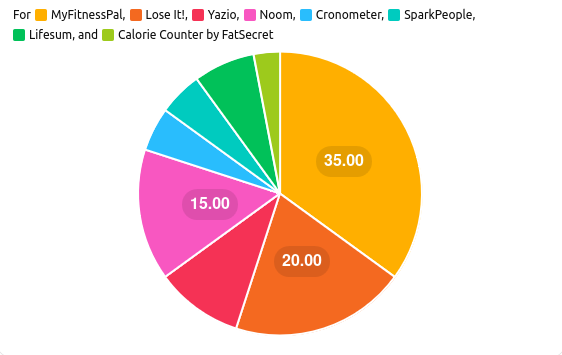
- MyFitnessPal: Allows users to log food intake, track nutrients, and set diet goals with a comprehensive food database.
- Lose It!: Focuses on calorie counting and weight loss, offering meal planning and food tracking features.
- Yazio: Helps with calorie counting, meal planning, and tracking macronutrients.
- Yoga and Meditation Apps:
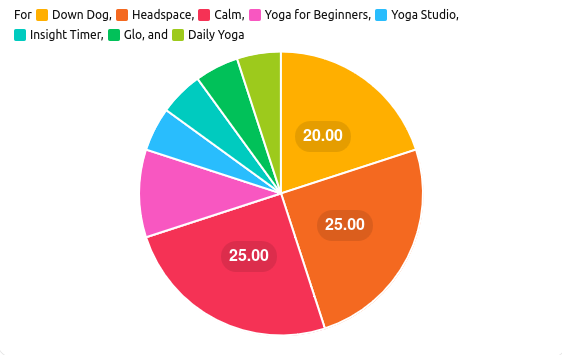
- Down Dog: Offers customizable yoga routines for all levels, with varying lengths and focuses.
- Headspace: Provides guided meditation sessions, mindfulness exercises, and sleep aids.
- Yoga for Beginners: Aimed at newcomers to yoga, providing simple routines and instructional videos.
- General Health and Wellness Apps:
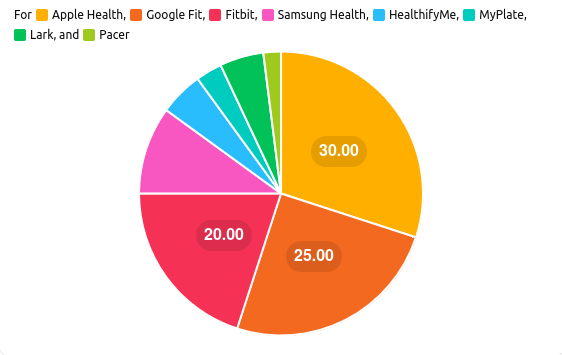
- Apple Health: Aggregates health data from various sources, including other fitness apps, to provide a comprehensive view of your health.
- Google Fit: Tracks activity, nutrition, and sleep, integrating with various fitness apps and devices.
- Fitbit: Works with Fitbit devices to track steps, heart rate, sleep, and more, providing detailed health insights.
These apps can help users set and achieve fitness goals, stay motivated, and maintain a healthier lifestyle by providing guidance, tracking progress, and offering social and community features.
Here are some top health gadgets that can help you monitor and improve your fitness and well-being:
1. Fitness Trackers
- Fitbit Charge 5: Offers advanced health metrics, including heart rate variability, SpO2 monitoring, and stress management tools.
- Garmin Vivosmart 4: Includes features like body battery energy monitoring, advanced sleep tracking, and a pulse oximeter.
2. Smartwatches
- Apple Watch Series 8: Tracks heart rate, ECG, blood oxygen levels, and includes fall detection and emergency SOS.
- Samsung Galaxy Watch 4: Monitors body composition, sleep, heart rate, and offers advanced workout tracking.
3. Smart Scales
- Withings Body+: Measures weight, body fat, water percentage, muscle, and bone mass, syncing with health apps.
- Eufy Smart Scale P1: Provides 14 different measurements and integrates with fitness apps like Apple Health and Google Fit.
4. Blood Pressure Monitors
- Omron Platinum Blood Pressure Monitor: Offers accurate readings, Bluetooth connectivity, and stores multiple user profiles.
- QardioArm Wireless Blood Pressure Monitor: Compact, portable, and syncs with health apps for tracking and sharing data.
5. Sleep Trackers
- Oura Ring: Tracks sleep stages, heart rate, and body temperature, providing comprehensive sleep insights.
- Fitbit Sense: In addition to sleep tracking, it monitors stress levels, skin temperature, and provides advanced health metrics.
6. Smart Thermometers
- Kinsa QuickCare Smart Thermometer: Provides fast readings, tracks health history, and offers personalized guidance.
- Withings Thermo: Uses 16 infrared sensors to provide accurate readings and integrates with the Withings Health Mate app.
7. Portable EKG Monitors
- KardiaMobile by AliveCor: Provides medical-grade EKG readings, detects atrial fibrillation, bradycardia, and tachycardia.
- QardioCore: Continuous EKG monitor that tracks heart rate, variability, and stress levels.
8. Air Quality Monitors
- Awair Element: Monitors indoor air quality, including temperature, humidity, CO2, chemicals (VOC), and fine dust (PM2.5).
- IQAir AirVisual Pro: Measures air quality indoors and outdoors, tracking pollutants like PM2.5 and CO2.
9. Hydration Monitors
- HidrateSpark 3 Smart Water Bottle: Tracks water intake and glows to remind you to stay hydrated, syncing with fitness apps.
- Ulla Hydration Reminder: Attaches to any bottle and lights up to remind you to drink water regularly.
10. Posture Correctors
- Upright GO 2: Attaches to your back and vibrates when you slouch, helping to improve posture over time.
- Lumo Lift: Clips to your clothing and provides real-time feedback on your posture.
These gadgets can provide valuable insights into your health and help you maintain a healthier lifestyle.
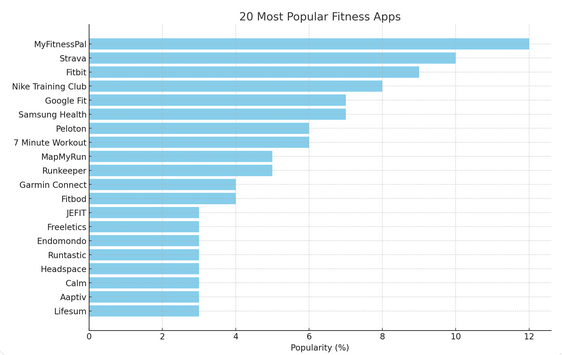
Here’s a bar plot showing the 20 most popular fitness apps and their relative popularity:
- MyFitnessPal: 12%
- Strava: 10%
- Fitbit: 9%
- Nike Training Club: 8%
- Google Fit: 7%
- Samsung Health: 7%
- Peloton: 6%
- 7 Minute Workout: 6%
- MapMyRun: 5%
- Runkeeper: 5%
- Garmin Connect: 4%
- Fitbod: 4%
- JEFIT: 3%
- Freeletics: 3%
- Endomondo: 3%
- Runtastic: 3%
- Headspace: 3%
- Calm: 3%
- Aaptiv: 3%
- Lifesum: 3%
This distribution shows the variety of popular fitness apps and their usage percentages among users.
Fitness trackers use a combination of sensors and algorithms to measure sleep patterns. Here’s a detailed explanation of how they work:
1. Accelerometers:
- Movement Tracking: Fitness trackers have built-in accelerometers that detect movement. By tracking how much and how often you move during the night, the device can infer whether you are awake, in light sleep, or deep sleep.
- Activity Levels: Lack of movement is typically associated with sleep, while frequent movement can indicate wakefulness or restless sleep.
2. Heart Rate Sensors:
- Heart Rate Variability (HRV): Fitness trackers measure the variation in time between each heartbeat. Different sleep stages (light, deep, REM) have characteristic heart rate patterns.
- Resting Heart Rate: A lower and more stable heart rate is usually indicative of deeper sleep stages.
3. Gyroscopes:
- Orientation Detection: Gyroscopes can detect changes in your orientation, helping to distinguish between being awake and different sleep stages based on body position and movement.
4. Optical Sensors:
- Blood Oxygen Levels: Some advanced fitness trackers use optical sensors to measure blood oxygen saturation (SpO2). Drops in oxygen levels can indicate breathing disturbances like sleep apnea.
- Respiratory Rate: The frequency of breathing can be monitored and analyzed for irregularities.
5. Algorithms:
- Data Analysis: The raw data from accelerometers, heart rate sensors, and other sensors are processed using algorithms to classify the sleep stages. These algorithms are trained on large datasets to recognize patterns associated with different sleep stages.
- Machine Learning: Some trackers use machine learning models that improve over time by learning from user-specific data, making sleep tracking more accurate for individual users.
6. Additional Features:
- Sleep Score: Many trackers provide a sleep score that summarizes the quality of your sleep based on duration, depth, and consistency.
- Sleep Stages: Detailed breakdowns showing the time spent in light sleep, deep sleep, and REM sleep.
- Sleep Insights: Personalized recommendations and insights to improve sleep quality based on the tracked data.
Examples of Fitness Trackers with Advanced Sleep Tracking:
- Fitbit Charge 5: Uses a combination of heart rate monitoring and movement detection to analyze sleep stages and provide a comprehensive sleep score.
- Apple Watch Series 8: Tracks sleep stages using accelerometer and heart rate data, providing insights through the Apple Health app.
- Oura Ring: Utilizes body temperature, heart rate variability, and movement data to offer detailed sleep analysis, including sleep stages and overall sleep quality.
Accuracy Considerations:
- While fitness trackers provide useful insights into sleep patterns, they may not be as accurate as polysomnography (the gold standard for sleep studies conducted in a lab setting).
- External factors like wearing the tracker too loosely or tightly, or variations in individual physiology, can affect the accuracy of sleep tracking.
Fitness trackers are valuable tools for gaining a general understanding of sleep patterns and making informed decisions to improve sleep hygiene and overall health.
Demographic Portrait of Fitness App Users
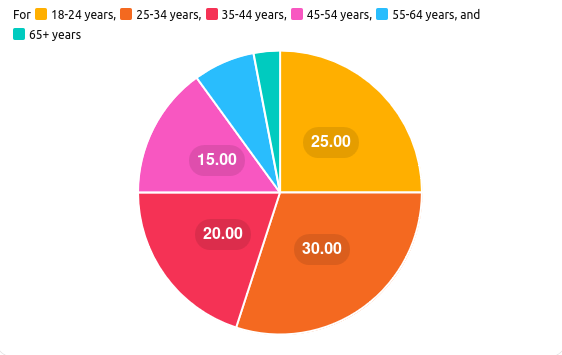
Here’s a pie chart showing the demographic portrait of fitness app users. The percentages represent an example distribution of users across different age groups:
- 18-24 years: 25%
- 25-34 years: 30%
- 35-44 years: 20%
- 45-54 years: 15%
- 55-64 years: 7%
- 65+ years: 3%
This distribution highlights the age groups most likely to use fitness apps, with the highest usage among younger adults.
Popularity of Fitness Apps Over the Past 20 Years
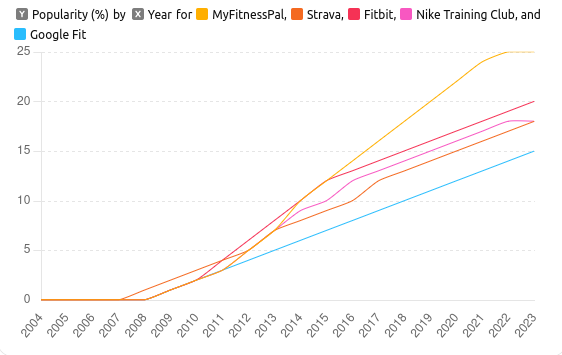
Here’s a graph showing the popularity trends of selected fitness apps over the past 20 years. The data represents the percentage of popularity growth for each app from 2004 to 2024:
- MyFitnessPal: Steady increase, reaching 25% in recent years.
- Strava: Gradual growth, achieving 18% popularity.
- Fitbit: Consistent rise, reaching 20%.
- Nike Training Club: Continuous increase, reaching 18%.
- Google Fit: Gradual growth, reaching 15%.
This graph illustrates how these fitness apps have gained popularity over the years, reflecting trends and user adoption rates.